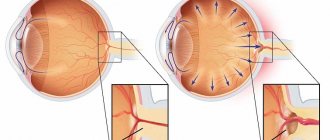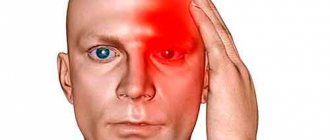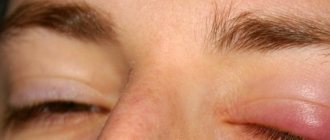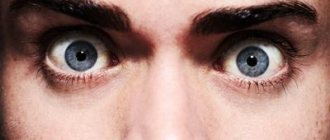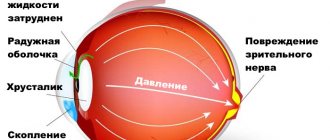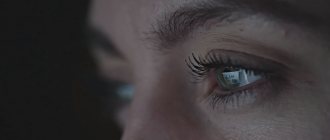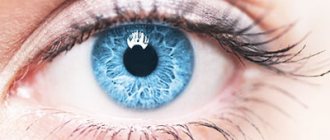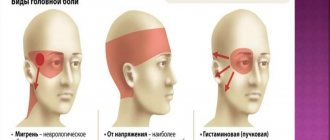Causes
Pain in the eyeballs is a rather unpleasant symptom that can occur in adults, men and women. Sometimes the symptom is observed in children, but such cases are rare.
There are physiological reasons that provoke pain:
- Nervous disorders of acute and chronic nature.
- Stressful situations associated with family problems or professional difficulties.
- Hypothermia, causing muscle spasms or disruption of nerve impulse conduction.
Eye pain when blinking and pressing may be due to wearing glasses for a long time - Long and regular work at the computer, accompanied by tension in the muscles of the eyeball.
- Being outside in windy weather.
- Entry into the eye of a foreign body of various sizes.
- Violation of personal hygiene rules, rare hand washing and exposure of germs to the mucous membrane of the upper and lower eyelids.
- Wearing contact lenses on a regular basis and violating the technique of their use.
- Overstrain of the muscles of the eyeball and disorders of the optic nerve.
- Congenital anomalies of the development of the visual apparatus.
In addition to pain, the patient may experience a burning sensation and the quality of vision decreases. Additional symptoms largely depend on the underlying cause of the condition.
Causes of pain in the corner of the eye
1.Canaliculitis
. Inflammation of the tear ducts causes pain in the inner corners of the eyes. Inflammation of the tear duct develops with infectious problems both in the eye itself and in the nasal cavity. Along with pain in the corner of the eye, swelling and redness of the lower or upper eyelid, lacrimation and purulent discharge from the eyes appear. Antibacterial and anti-inflammatory drops are used for treatment.
2.
Partial or complete obstruction of the lacrimal ducts
.
Causes active lacrimation and discomfort in the inner corner of the eyes. The cause may be injury or tumors of the tear ducts. Often, for this reason, surgical treatment is necessary to restore the patency of the tear ducts.
3.Dacryocystitis
. Inflammation of the lacrimal sac will also cause localized pain in the inner corner of the eye. The inner corner of the eye swells and profuse purulent discharge appears. In most cases, it resolves with conservative treatment. Sometimes surgical treatment is required
4.Blepharitis.
Inflammation of the skin of the eyelids in the initial stages causes discomfort and itching in the corners of the eyes, both externally and internally.
5. Angular conjunctivitis
. Infectious inflammation of the mucous membrane caused by the Morax-Axenfeld bacterium affects the skin of the eyelids in the corner of the eyes. In this case, a characteristic clinical picture develops: the corners of the eyes hurt, turn red, and small cracks appear. Pain in the corners of the eyes worsens when blinking.
6.Ocular herpes
. A herpetic eye infection may begin with discomfort in the outer corner of the eye. As symptoms increase, swelling of the eyelid, pain in the eyes, redness and photophobia appear.
7.Ingrown hair (eyelashes)
Ingrown hairs in the inner corner of the eye can cause discomfort and redness in the inner corner of the eye. However, it is impossible to see the problem with the naked eye.
8.Allergic conjunctivitis.
If you experience nasal congestion and watery eyes along with unpleasant sensations in the corners of your eyes, an allergy may be the cause. Treatment is carried out with antihistamines.
9. Wrong glasses
. In some cases, improper adjustment of the nose pads in the frames of glasses causes pain or discomfort in the corners of the eyes.
10. Computer vision syndrome.
Many people experience gas discomfort and discomfort in the corners of their eyes when looking at computer screens, tablets and phones. The severity of symptoms directly depends on the amount of time spent looking at the screen. Go away on their own after rest or sleep.
Possible diseases
The eye hurts when blinking and pressing, not only as a result of physiological factors. The cause may be various infectious and inflammatory diseases affecting the mucous membranes, eyeball, muscles and nerves.
- Conjunctivitis is an inflammatory disease of the mucous membrane of the eyelids, accompanied by souring of the eyes, pain when blinking and pressing, and tearing. The disease can be of viral, infectious, or bacterial origin. Sometimes inflammation is triggered by an allergic reaction to food, medications, or toxic substances.
- Blepharitis – inflammation of the edge of the eyelids, accompanied by severe pain when blinking and pressing, as well as burning and irritation. In this case, the pathology is often chronic, that is, regular relapses are observed. Dry crusts often appear on the skin of the eyelids in the eyelash area, which are formed as a result of constant damage to the skin when combing it.
- Barley is another inflammatory disease that develops as a result of blockage of the glands that provide lubrication of the eyelids with sebaceous secretions. In this case, the patient is worried not only about pain, but also about swelling, redness of the affected area, the formation of a dense lesion, when touched, the pain intensifies. The disease is very common, especially among young patients.
- Iridocyclitis is a pathology of the middle choroid and iris of the eye, in which the patient constantly feels pain, especially after stress on the visual apparatus. His vision deteriorates, his eyes often turn sour. Additionally, small vessels in the eyeball are often damaged, which leads to the formation of a vascular network on the protein.
- Myositis is an inflammatory disease of the muscle that responds to eyeball movements. In this case, severe pain appears when blinking, less pronounced discomfort when pressing on the eyelid, as well as swelling of the skin in the eye area.
- A furuncle is an inflammatory pathology that affects the hair follicle located near the eye. In this case, the condition is accompanied by pain when pressing, blinking, as well as severe swelling and redness. In the absence of therapy, general symptoms appear.
- An abscess is a purulent inflammation that is usually the result of an untreated boil or a complete lack of treatment for such a disease. In this case, all the symptoms worsen, the body temperature rises, and the pain becomes unbearable, appearing when moving the eyes and at rest.
- Cellulitis is another complication that develops when a boil or abscess is not treated correctly. In this case, not just inflammation of the tissues occurs, but also their necrosis. The condition requires immediate medical attention.
- Rhinitis the chronic form can also cause pain. In this case, the patient notes that the symptom appears when blinking, but is almost absent when pressing. The condition is accompanied by nasal congestion and headache.
- Obstruction of the lacrimal ducts often leads to pain when blinking or pressing. In this case, inflammation develops in the lacrimal gland, slight swelling of the tissues is observed, as well as discomfort, which manifests itself at rest and in case of tension in the visual apparatus.
- Chalazion is a benign formation localized in the upper or lower eyelid. It provokes swelling of the tissues, the appearance of bruises or reddish circles under the eyes. The pathology requires immediate treatment, which often involves surgery.
- Neuritis or neuralgia of the nerve endings responsible for the innervation of the eye occurs when hypothermia or damage to the neurons occurs. In this case, not only pain appears, but also discomfort when moving the facial muscles; paralysis of individual fibers is possible, affecting a person’s facial expressions.
- Colds and viral pathologies can also provoke pain, especially when they are advanced and the patient does not receive appropriate treatment. Symptoms usually disappear after recovery.
Regardless of the pathology that provokes the pain, you should not ignore the symptom, especially if it appears constantly.
Why does the eye hurt when blinking and pressing?
Ophthalmologists identify symptoms that arise for the following reasons:
- conjunctivitis (viral, bacterial, fungal, allergic) – inflammation of the conjunctiva of the eye, accompanied by redness, swelling, and sometimes discharge of pus;
- blepharitis is an inflammatory condition of the eyelids;
- keratitis – inflammation of the cornea;
- overwork due to frequent use of electronic gadgets or during their incorrect use;
- barley - subcutaneous proliferation of a bacterial infection that develops on the eyelids in the gland area;
- boil - a pathology accompanied by infection of the subcutaneous layers, which has a deep core;
- foreign body ingress, burn;
- glaucoma – increased intraocular pressure that develops as a result of impaired outflow of secreted fluid in the anterior or posterior chamber of the eye;
- migraine, in which not only the head but also the eyes hurt, the discomfort intensifies when pressing on them.
Each condition or disease is treated differently. Because of this, the doctor must identify the true cause, only then begin treatment.
Diagnostics
The eye hurts when blinking and pressing for various reasons, but to identify the most likely factor, you should consult a doctor, who will establish a diagnosis using several methods.
| Method | Description | Cost and venue |
| General examination and questioning of the patient | A standard procedure in which the doctor listens to the patient’s complaints, determines the probable cause of the disorder, as well as the conditions for the appearance and disappearance of the symptom | Carried out in a public clinic free of charge |
| Clinical and biochemical blood test | A method for assessing a patient's condition by examining venous blood. In this case, you can detect signs of general inflammation, as well as other abnormalities. | The examination is available in private and public clinics. In the first, its cost usually does not exceed 500 rubles. |
| Bacteriological analysis of eye discharge | This diagnostic method involves taking a smear from the eyes followed by laboratory testing to identify the type of pathogen. Diagnosis is not always carried out, but only if a bacterial origin of the disease that provokes pain is suspected | Conducted in a public clinic, does not require payment from the patient |
| Determination of visual acuity | In this case, the standard method is used when the patient names the symbols or letters on the table. The method is considered additional, but helps to get a general picture of the condition | The method is available to public clinics and is free of charge. |
| Measuring intraocular pressure indicators | One of the important and most effective methods, when using a special device, measures intraocular pressure that can affect the condition of the visual apparatus and provoke pain. | Another free method that is used in public clinics |
| MRI | The most effective diagnostic method to detect changes occurring in muscle fibers and nerve endings | The procedure is carried out in institutions that have the appropriate equipment. The cost ranges from 1000-3000 rubles. |
The most effective is the measurement of intraocular pressure, as well as magnetic resonance imaging, which can detect even minor changes.
What to do if your eye hurts when blinking
Doctors do not recommend self-medication.
It is better if the patient contacts an ophthalmologist at the first signs of the disease to conduct diagnostic tests:
- assessment of visual acuity;
- measurement of intraocular pressure;
- determination of the inflammatory process, infection of soft tissues;
- general examination of the cornea for foreign substances;
- fundus examination;
- bacterial culture, microscopy, virological test.
During a general examination, the ophthalmologist can detect redness, inflammation, swelling, and suppuration. These symptoms suggest a diagnosis.
If the doctor believes that the cause is a bacterial infection, antibiotics will be prescribed. But it is better to initially conduct a bacteriological culture to identify the pathogen and the exact drug to which it is sensitive.
The presence of a foreign body can be determined independently. But a person does not always extract it by washing. If this fails, or the damage is extensive, it is recommended to consult an ophthalmologist or traumatologist.
Prevention
To prevent such a violation, it is recommended to follow the rules of personal hygiene, often wash your hands with soap to prevent bacteria from entering the mucous membrane.
In addition, patients who regularly use contact lenses should follow all wearing rules, change them regularly, and use a special storage solution. Many people are advised to use lenses that are designed to be worn only during the day. Changing lenses daily will eliminate the possibility of infection.
Additionally, you should avoid hypothermia and promptly treat colds and viral diseases. The most important method of preventing complications is to consult a doctor immediately after the first signs of any disease appear in the form of discomfort and pain when blinking.
Conjunctivitis
Conjunctivitis is an inflammation of the mucous membrane of the eyes. This ophthalmological phenomenon can be caused by fungi, viruses, infection or allergies. Most often it occurs during the period of vitamin deficiency and decreased immunity in spring and autumn. Characteristic symptoms:
- the corner of the eye hurts when blinking;
- sensation of a foreign object;
- pain in the eye;
- burning;
- redness of the eye;
- lacrimation;
- purulent discharge;
- eyelashes stick together;
- swelling of the eyelids.
This disease can spread to the healthy eye.
Therefore, both eyes need to be treated at once. If the doctor has diagnosed a bacterial infection, then treatment includes the use of antibacterial drops (Tobrex, Albucid). For viral conjunctivitis, Floxal, Oftadecom are prescribed, and for the allergic form of conjunctivitis, antihistamine drops Ketotifen or Allergodil are prescribed.
Treatment methods
To eliminate pain and other symptoms, medications from different groups, folk remedies and additional methods are used.
Medications
The drug treatment regimen is compiled individually for each patient, depending on the underlying disease that causes pain when blinking and pressing on the eye.
The most commonly used drugs are:
- Ceftriaxone – a broad-spectrum antibiotic that is used when the bacterial origin of pain and inflammation is detected. 1 g is administered to the patient intravenously or intramuscularly in the morning and evening. The course lasts 10 days. The product helps suppress pathogenic bacteria and eliminate inflammation. The price of the medicine is from 20 rubles. per bottle.
- Viferon is an antiviral ointment for the treatment of pathologies of the mucous membranes of the eyelids of viral origin. Helps suppress the activity of viruses, improves tissue condition, and is effective. Apply the product to the mucous membranes, then massage the upper eyelid for 5-10 seconds. Repeat the procedure 2 times a day for 10 days. The price of the ointment is from 150 rubles.
- Albucid - eye drops that are highly effective. They help destroy pathogenic microbes, improve the condition of the mucous membrane, and eliminate signs of inflammation. It is necessary to instill 1 drop into each eye, repeat 3 times a day for 5-7 days. Price – from 30 rub.
- Uniflox is a drug based on an antibacterial substance that eliminates redness, inflammation and pain in the eyes resulting from inflammatory diseases. It is considered very effective, helping to quickly improve the patient's condition. It is necessary to apply eye drops 2 times a day, 1 drop in each eye. Course duration – from 180 rubles.
- Diklo-F - eye drops from the group of non-steroidal anti-inflammatory drugs, are considered very effective and fast-acting. Helps quickly relieve pain, inflammation and redness. It is necessary to instill 1-2 drops of the product into each eye 2-4 times a day for 6-7 days. The price of drops is from 150 rubles.
- Dexamethasone is a drug based on a hormonal component that quickly eliminates pain, inflammation and other manifestations. It is highly effective and helps prevent complications. You should use drops no more than 2 times a day, inject 1-2 drops into each eye, repeat for 7 days in a row. The price of the product is from 120 rubles.
Additionally, the patient may be prescribed vitamin complexes with a high content of B vitamins. In each case, the drugs are selected individually.
Folk remedies
The eye hurts when blinking and pressing, not only as a result of any diseases. The cause may be a physiological factor that can be eliminated with the help of folk remedies.
Aloe juice compresses are good for calming and relieving tension. It is necessary to chop several large leaves of the plant, squeeze out the juice and moisten a gauze cloth in it. Apply to eyes for 30 minutes. Repeat the procedure 7 days in a row, morning and evening.
Regular tea bags can serve as a compress replacement. You need to take 2 used sachets, preferably warm ones, and apply them to your eyes for 20-30 minutes. Repeat the procedure before bedtime for 10 days.
An infusion based on chamomile and mint will help relieve nervous tension, improve sleep and prevent pain. You can prepare it from 3 g of chamomile and 4 g of mint. The raw materials should be crushed, pour 500 ml of boiling water and leave for 20 minutes. Divide the filtered mixture into 2 servings and consume throughout the day. Repeat for 2 weeks.
It is better to use any of the recipes after consulting a doctor.
Other methods
Additional treatment methods include surgical intervention, which is performed when a chalazion, boil or abscess is detected in the eye area.
The procedure is performed under short-term general or local anesthesia. During the manipulation, the specialist makes miniature incisions in the area of the lesion and cleans out the cavity, as well as all affected tissue. This allows you to eliminate swelling, as well as treat the cavity with antiseptic solutions to prevent the proliferation of microorganisms.
After the operation, the patient remains under the supervision of a specialist in the hospital for several days. If there are no signs of complications and the patient feels well, he is sent home. However, dressings are carried out for another 10-14 days, depending on the size of the lesion and the speed of tissue healing.
During the recovery period, the patient feels pain when blinking and pressing on the eyeball, but the discomfort disappears after the tissue heals. If the pain persists, you should visit the doctor again. Other methods for this disorder are used extremely rarely, as they can provoke complications.
Possible complications
Without treatment, the likelihood of complications increases.
The most common of them are the following:
- Decreased visual acuity.
- Spread of inflammation to the second eye.
- Irreversible changes in muscle and nerve fibers.
- Infection of healthy tissues due to the spread of microorganisms.
- Tissue necrosis when phlegmon spreads to large areas.
- Complete loss of vision.
Only comprehensive treatment prescribed after the examination will help prevent complications.
The eye often hurts in patients as a result of pathological and physiological reasons. Discomfort appears when blinking and pressing, and may disappear on its own or provoke other symptoms. To eliminate the problem, you should visit an ophthalmologist.
Article design: Vladimir the Great
